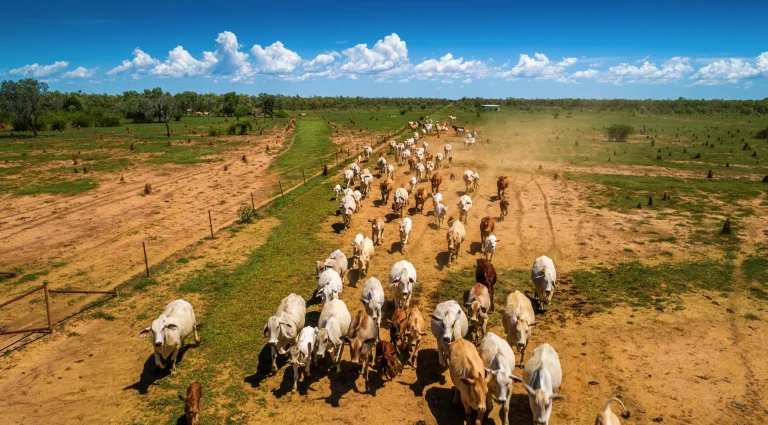Guidelines for Investing in Queensland’s Cotton Farming Sector
Queensland’s cotton farming sector presents compelling opportunities for investors seeking to capitalize on one of Australia’s most valuable agricultural commodities. With its favorable climate, advanced irrigation infrastructure, and established supply chains, the state offers a robust foundation for cotton production investments. Understanding the guidelines for investing in Queensland’s cotton farming sector requires careful consideration of multiple factors, from soil quality and water access to market dynamics and regulatory requirements.
At Agribusiness Horizons, we specialize in facilitating high-value agricultural property transactions across Queensland’s cotton regions. Our expertise in cotton farming investments helps clients navigate the complexities of this sector while maximizing returns. Whether you’re considering your first cotton farm acquisition or expanding an existing portfolio, our team provides comprehensive guidance throughout the investment process. Contact us today to discuss how we can help you identify and secure premium cotton farming opportunities in Queensland.
Queensland’s Cotton Farming Landscape
Queensland’s cotton industry has evolved into a sophisticated agricultural sector that combines traditional farming expertise with modern technology. The state’s cotton-growing regions benefit from diverse climatic conditions, ranging from the fertile Darling Downs to the expansive plains of Central Queensland. These areas have established themselves as prime cotton production zones through decades of agricultural development and infrastructure investment.
The sector’s maturity is evident in its integrated supply chain, which includes ginning facilities, storage infrastructure, and transportation networks specifically designed for cotton handling. This established framework provides investors with confidence in the sector’s operational efficiency and market connectivity. The presence of major cotton marketing companies and processing facilities throughout Queensland ensures reliable pathways from farm gate to international markets.
Water security remains a fundamental consideration in Queensland’s cotton regions, with many properties featuring sophisticated irrigation systems and water storage infrastructure. The state’s approach to water management, including the development of water trading markets and allocation systems, provides investors with various options for securing water rights alongside land acquisitions.
Investment Fundamentals and Market Dynamics
Successful cotton farming investments in Queensland require understanding the sector’s unique characteristics and market drivers. Cotton production operates on seasonal cycles that demand significant working capital, with planting decisions influenced by water availability, commodity prices, and weather forecasts. This cyclical nature creates both opportunities and challenges for investors, making timing and financial planning crucial elements of any investment strategy.
The Queensland cotton sector benefits from strong domestic processing capabilities and established export relationships, particularly with Asian markets. This market positioning provides stability and growth potential for well-managed operations. However, investors must consider the sector’s exposure to international commodity price fluctuations and currency movements, which can significantly impact profitability.
Technology adoption in Queensland’s cotton industry has accelerated in recent years, with precision agriculture, automated irrigation systems, and data-driven decision making becoming standard practices. Properties equipped with modern technology typically command premium valuations and offer superior operational efficiency. When evaluating guidelines for investing in Queensland’s cotton farming sector, investors should prioritize properties with up-to-date infrastructure and technology systems.
Property Selection and Due Diligence
Identifying suitable cotton farming properties requires comprehensive evaluation of multiple factors that influence long-term viability and profitability. Soil quality stands as the primary consideration, with cotton requiring well-drained soils with good structure and fertility. Properties with diverse soil types can offer flexibility in crop rotation and risk management, while those with premium cotton-growing soils command higher valuations.
Water access and irrigation infrastructure represent critical investment considerations. Properties with secure water allocations, whether through underground sources or surface water rights, provide operational certainty and enhanced value. Modern irrigation systems, including center pivot and lateral move systems, offer efficiency advantages and labor savings that improve overall returns.
Location factors significantly influence property values and operational efficiency. Proximity to ginning facilities, storage infrastructure, and transportation networks affects both operational costs and logistics efficiency. Properties located in established cotton-growing regions typically benefit from better service provider networks and industry support systems.
The due diligence process should encompass soil testing, water rights verification, infrastructure assessment, and financial performance analysis. Professional agronomic assessments help identify potential productivity improvements and ongoing maintenance requirements. Environmental considerations, including compliance with sustainable farming practices and regulatory requirements, are increasingly important for long-term value preservation.
Financial Considerations and Investment Structures
Cotton farming investments require substantial capital commitments that extend beyond initial property acquisition costs. Working capital requirements for cotton production can be significant, with input costs including seed, fertilizers, pest control, and irrigation expenses occurring months before harvest revenues. Investors must plan for these cash flow cycles and ensure adequate financing arrangements.
Property valuations in the cotton sector reflect multiple factors including soil quality, water security, infrastructure quality, and historical production performance. Professional valuation services help establish fair market values and identify properties offering strong value propositions. Properties with proven track records of high yields and efficient operations typically command premium pricing.
Various ownership structures are available for cotton farming investments, from direct ownership to partnership arrangements and managed investment schemes. Each structure offers different risk profiles, tax implications, and management responsibilities. Professional advice helps determine the most suitable structure based on individual circumstances and investment objectives.
Financing options for cotton farming investments include traditional agricultural loans, equipment financing, and specialized rural lending products. Lenders typically require detailed business plans, cash flow projections, and security arrangements. Established relationships with agricultural lenders can facilitate financing approval and potentially secure more favorable terms.
Risk Management and Operational Excellence
Cotton farming involves multiple risk factors that require careful management and mitigation strategies. Weather risks, including drought, flooding, and extreme temperatures, can significantly impact production outcomes. Crop insurance products provide protection against weather-related losses, while diversification strategies can reduce overall portfolio risk.
Market risk management involves understanding commodity price cycles and implementing appropriate hedging strategies. Forward contracting, futures markets, and price pooling arrangements offer various approaches to managing price volatility. Successful cotton investors typically develop sophisticated risk management frameworks that balance price protection with profit potential.
Operational risks include equipment breakdowns, labor shortages, and pest management challenges. Preventive maintenance programs, reliable contractor relationships, and integrated pest management systems help minimize these risks. Properties with modern equipment and well-maintained infrastructure typically experience fewer operational disruptions.
Environmental and regulatory compliance represents an increasingly important risk consideration. Sustainable farming practices, water use efficiency, and environmental stewardship are becoming essential requirements for long-term viability. Properties with strong environmental credentials and compliance records offer better risk profiles and potential premium valuations.
Comparison of Cotton Investment Approaches
| Investment Approach | Capital Requirements | Management Involvement | Risk Profile | Return Potential |
|---|---|---|---|---|
| Direct Ownership | High | High | Moderate to High | High |
| Share Farming | Moderate | Moderate | Moderate | Moderate |
| Managed Schemes | Variable | Low | Low to Moderate | Moderate |
| Contract Farming | Low | Low | Low | Low to Moderate |
Understanding these different approaches helps investors select the most appropriate strategy based on their capital availability, risk tolerance, and desired level of involvement. Each approach offers distinct advantages and considerations that align with different investment objectives and guidelines for investing in Queensland’s cotton farming sector.
Agribusiness Horizons’ Cotton Sector Expertise
Our team at Agribusiness Horizons brings extensive experience in Queensland’s cotton farming sector, having facilitated numerous high-value transactions across the state’s primary cotton-growing regions. We understand the unique characteristics of cotton farming investments and provide specialized guidance throughout the acquisition process.
Our comprehensive approach to cotton farming investments includes detailed property analysis, water rights assessment, infrastructure evaluation, and financial modeling. We work closely with clients to identify properties that align with their investment criteria and risk tolerance. Our network of industry contacts, including agronomists, water specialists, and financial advisors, ensures clients receive expert guidance across all aspects of their investment.
We provide ongoing support beyond property acquisition, including assistance with operational optimization, technology upgrades, and strategic planning. Our understanding of guidelines for investing in Queensland’s cotton farming sector enables us to help clients maximize returns while managing risks effectively. Whether you’re seeking your first cotton farming investment or expanding an existing portfolio, our expertise ensures you make informed decisions based on comprehensive market knowledge and professional analysis.
Future Trends and Market Outlook
Queensland’s cotton farming sector continues to evolve with technological advances and changing market dynamics. Precision agriculture technologies, including satellite monitoring, variable rate application systems, and automated irrigation management, are becoming standard practices that improve efficiency and reduce costs. Properties equipped with these technologies typically achieve superior performance and command premium valuations.
Sustainability considerations are increasingly influencing investment decisions, with environmental credentials becoming important value drivers. Properties demonstrating water use efficiency, soil health management, and biodiversity conservation often attract premium pricing and improved market access. Carbon farming opportunities may provide additional revenue streams for well-managed cotton operations.
Market access and supply chain developments continue to shape investment opportunities. Queensland’s strategic location provides advantages for accessing Asian markets, while domestic processing capabilities support local value-adding opportunities. Infrastructure investments, including transportation upgrades and storage facilities, enhance the sector’s competitiveness and investment attractiveness.
Climate adaptation strategies are becoming increasingly important for long-term investment success. Properties with climate resilience features, including drought-tolerant varieties, efficient irrigation systems, and diversification options, offer better risk management capabilities. Understanding these trends helps investors identify properties positioned for long-term success in Queensland’s evolving cotton sector.
Conclusion
Successfully navigating the guidelines for investing in Queensland’s cotton farming sector requires comprehensive understanding of the industry’s unique characteristics, market dynamics, and risk factors. From property selection and due diligence to financial planning and risk management, each aspect demands careful consideration and professional guidance.
The sector’s combination of established infrastructure, technological advancement, and market access creates compelling opportunities for informed investors. However, success depends on thorough preparation, appropriate risk management, and ongoing operational excellence. Properties with superior soil quality, secure water access, and modern infrastructure typically offer the best investment prospects.
As you consider cotton farming investments in Queensland, what specific regions or property characteristics align best with your investment objectives? How will you balance the sector’s growth potential with its inherent risks and capital requirements? What role will sustainability and environmental stewardship play in your investment strategy?
At Agribusiness Horizons, we’re committed to helping investors achieve success in Queensland’s cotton farming sector. Our expertise in agricultural property transactions, combined with deep industry knowledge, ensures you receive the guidance needed to make informed investment decisions. Contact us today to discuss your cotton farming investment goals and learn how we can help you identify and secure premium opportunities in this dynamic sector.



